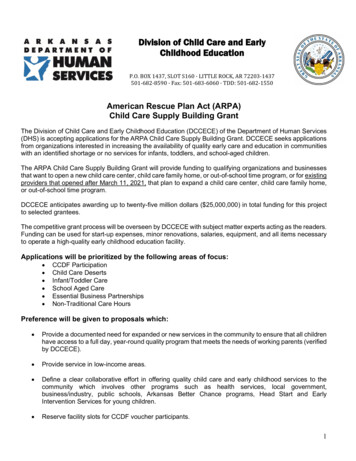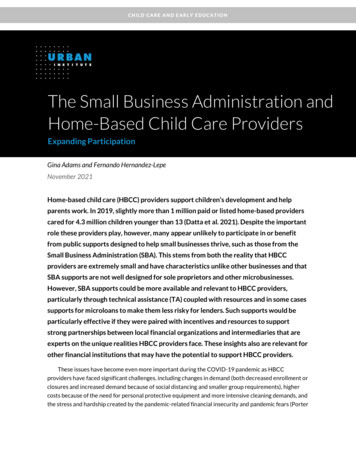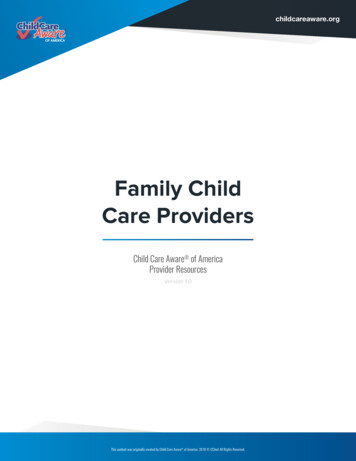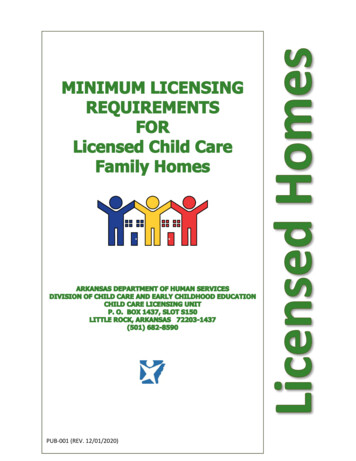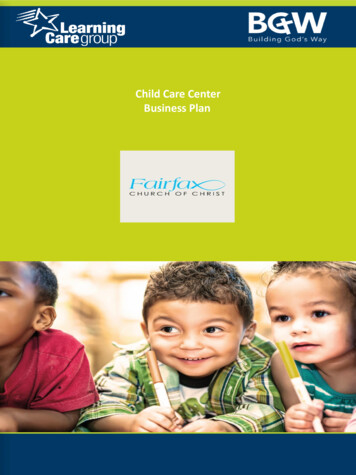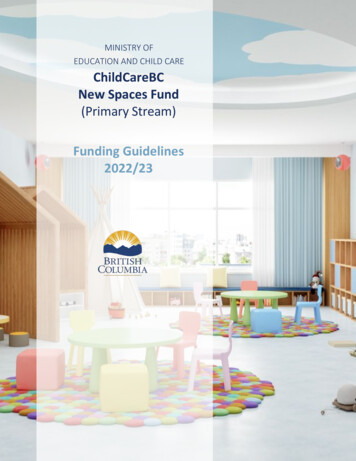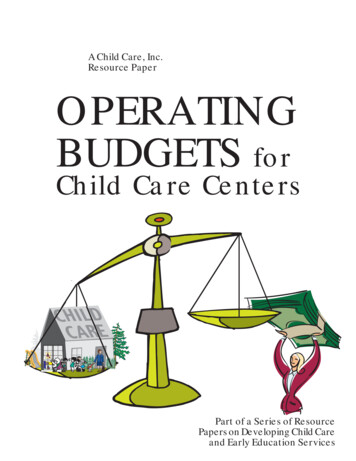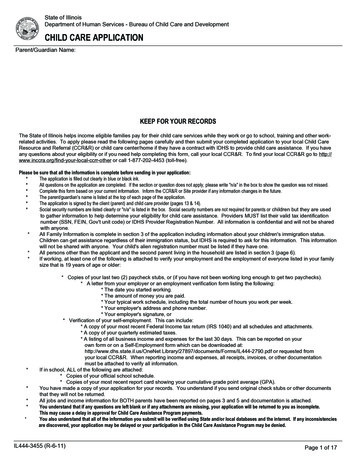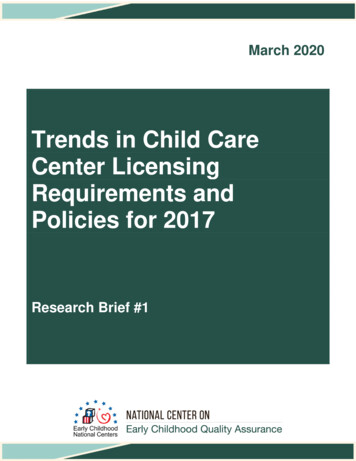
Transcription
March 2020Trends in Child CareCenter LicensingRequirements andPolicies for 2017Research Brief #1
AcknowledgementsThis document was developed with funds from Grant # 90TA0002-01-00 for the U.S.Department of Health and Human Services, Administration for Children and Families, Office ofHead Start, Office of Child Care, and Health Resources and Services Administration, by theNational Center on Early Childhood Quality Assurance. This resource may be duplicated fornoncommercial uses without permission.
Licensing Trends 2017Child Care CentersResearch Brief 1: Trends in Child Care CenterLicensing Requirements and PoliciesContentsIntroductionScope and PurposeMethodology334Compilation of State Licensing Requirements4NARA Survey of Licensing Programs and Policies4Comparative Analysis4Summary of Key Findings5Trends in State Licensing Requirements for Child Care Centers7Child Care Centers Licensed7Number of Licensed Child Care Centers7Licensed Capacity in Child Care Centers8Definition of Licensed Child Care Centers8Licensing Exemptions9Staff Roles and Age Requirements9Staff Education and Ongoing Training Requirements10Orientation Training11Health and Safety Topics Required in Preservice and Orientation Training11Background Checks13Staff Health and Hiring Requirements14Child-Staff Ratios and Group Sizes14Supervision of Children16Health Requirements and Medical Care16Nutrition and Maintaining Healthy Weight17Activities, Equipment, and Materials18Family Involvement19Behavioral Guidance and Discipline19Child Assessment19Care of Infants and Toddlers19Care of School-Age Children20Care of Children with Disabilities or Other Special Needs21March 20201
Trends in Child Care Center Licensing for 2017Transportation21Facility Health and Safety Requirements22Trends in State Licensing Agency Policies24Licensing Staff Assignments and Caseloads for All Facility Types24Frequency of Licensing for Child Care Centers24Types of Inspections for Child Care Centers24Frequency of Inspections for Child Care Centers25Monitoring Tools Used with All Facility Types26Use of Technology for Licensing Child Care Facilities28Enforcement Actions Used with Child Care Centers29Illegally Operating Child Care Providers29Complaint Investigations in Child Care Facilities30Licensing Fees for Child Care Centers31Child Care Licensing Staff Requirements31Child Care Licensing Staff Supports33Conclusion33References34March 20202
Trends in Child Care Center Licensing for 2017IntroductionWithin the early care and education system, licensing provides the baseline of protection for children and coversthe broadest content, the largest number of children from birth to school age, and the largest population ofproviders. Licensing helps prevent various forms of harm to children—risks from the spread of disease; fire andother building safety hazards; injury; and developmental impairment from the lack of healthy relationships withadults, adequate supervision, or developmentally appropriate activities.Licensing is a process administered by state and territory governments that sets a baseline of requirements belowwhich it is illegal for facilities to operate.1 States have regulations with which facilities must comply and policies tosupport the enforcement of those regulations. Some states may call their regulatory processes “certification” or“registration,” but for consistency, this research brief uses the terms “licensing” and “licensed” to represent allregulatory processes.The data presented in this brief are from the 2017 Child Care Licensing Study, which is the latest in a series oflarge-scale research studies of requirements for child care providers and facilities as well as policies andpractices for licensing agencies. Data are collected for the Child Care Licensing Studies through a documentreview of state child care licensing regulations and a survey of state licensing agencies. The National Center onEarly Childhood Quality Assurance (ECQA Center) has conducted these studies in partnership with the NationalAssociation for Regulatory Administration (NARA) every three years since 2005.The data and findings from this research allow states and territories to compare their licensing requirements andpolices to national data and track trends over time. These national findings can also inform comparisons withother systems in early care and education, such as quality improvement systems. We encourage otherresearchers to conduct further analysis with these data to answer questions for the field.Scope and PurposeThe purpose of this research brief is to report on the licensing requirements and policies for child care centersfor all 50 states and the District of Columbia. The term “state” will be used for all 51 jurisdictions.States may define child care centers differently in their licensing requirements. For the purpose of categorizing thetypes of center-based child care settings states regulate, the following definition is used:Child care services for fewer than 24 hours per day per child in a nonresidential setting, unless care inexcess of 24 hours is due to the nature of the parent(s)’ work (National Center on Early Childhood QualityAssurance, 2015).In other research briefs in this series, licensing requirements and policies for family child care homes and groupchild care homes are addressed.Using data compiled from state child care licensing regulations and the results from a survey of state licensingagencies by the National Association for Regulatory Administration (NARA), the National Center on EarlyChildhood Quality Assurance conducted an analysis that examines the state of licensing in 2017 and identifiestrends that have emerged during several years of data collection.“Licensing” or “licensed” is defined as permission that providers must obtain from a state to operate a child care facility, which requiresmeeting specific program standards.1March 20203
Trends in Child Care Center Licensing for 2017MethodologyCompilation of State Licensing RequirementsFor this research, all data regarding child care center requirements were compiled from the regulations postedin the National Database of Child Care Licensing Regulations that were in effect as of December 31, 2017. Thelicensing requirements data presented in this research brief include information only from state child carelicensing regulations. Additional requirements for child care facilities may be in state statutes; administrativecodes; or other local, state, or federal laws. It was not in the scope of this work to review all laws that pertain tochild care facilities.NARA Survey of Licensing Programs and PoliciesThe data about states’ licensing policies, including facility monitoring, enforcement of licensing regulations, andlicensing program staffing, were gathered by NARA in the 2017 NARA Child Care Licensing Programs andPolicies Survey. NARA sent the online survey via SurveyMonkey to all state child care licensing agencies inMarch 2018. Respondents submitted their answers electronically, and by January 2019, all 50 states and theDistrict of Columbia had responded.Comparative AnalysisThis brief includes a comparison with the findings from the 2014 Child Care Licensing Study that were reported inthe ECQA Center’s Research Brief #1: Trends in Child Care Center Licensing Regulations and Policies for 2014.The brief, published in 2015, includes a comparison of the 2014 data with previous Child Care Licensing Studiesfrom 2005, 2007, 2008, and 2011.2The number of states included in the data set for 2017 differs from 2014. This is because two U.S. territories didnot respond to the 2017 NARA Child Care Licensing Programs and Policies Survey. Throughout the brief, notesexplain that the data set for 2017 has 51 states, including the District of Columbia, and the data set from 2014 has53 states, including the District of Columbia and 2 territories (Guam and the Virgin Islands).In this brief, findings that show a significant increase or decrease in the number or percentage of states with aspecific requirement or policy are identified with upward and downward facing arrows, shown below: If there is no arrow next to a finding, the number or percentage of states changed by a very small amount orstayed the same from 2014 to 2017. Please note that some changes may also be due to the differences in thenumber of states in each set of data.2Findings from the 2011 Child Care Licensing Study are available in Research Brief #1: Trends in Child Care Center Licensing Regulationsand Policies for 2011 at ions-and-policies2011. Reports from the 2005, 2007, and 2008 studies are available at study.March 20204
Trends in Child Care Center Licensing for 2017Summary of Key FindingsKey findings emerged from review and comparison of all data collected in 2014 and 2017. The data for thesefindings and many other indicators are detailed in the remaining sections of this research brief.Findings: Licensing Requirements for Child Care CentersSince 2014, more than two-thirds of states (36; 71 percent) have made changes to their licensingregulations for child care centers, and many significant trends have emerged: The number of licensed child care centers has decreased by 0.66 percent, but the licensed capacity incenters has increased by 3.35 percent. States have increased the preservice qualifications required for teachers and directors, including theamount of administrative training required for directors. States have increased the number of annual training hours for at least one center role. The mediannumber of required training hours for all center roles is 15. Many states added a requirement that staff must complete orientation training to work in a center. Thishas increased from 29 states to 47 since 2014. Several states added preservice or orientation training requirements in health and safety topics from2014 to 2017. The largest increases were in the topics related to the care of infants—reducing suddeninfant death syndrome (16 states to 29) and prevention of shaken baby syndrome (11 states to 26). Several more states required five types of background checks—criminal history records, statefingerprints, federal fingerprints, child abuse and neglect registries, and the sex offender registry—forcenter staff. This number has increased from 16 to 34 states between 2014 and 2017. Since 2014, 4 states have lowered child-staff ratios for at least one age group. In 2017, 35 states had group-size requirements for all age groups, and 7 states had group-sizerequirements for least one age group. This is an increase from 2014, when 31 states regulated groupsize for all ages, and 10 states regulated group size for at least one age group. Nine states added requirements for centers about emergency preparedness procedures or having anemergency and evacuation plan. Six states added requirements for centers about having a fire extinguisher; with three of them alsoadding requirements about having a smoke detector. Eight states added requirements about reporting injuries or deaths that occur to children in child carecenters since 2014.March 20205
Trends in Child Care Center Licensing for 2017Findings: Licensing Agency Policies for Child Care CentersThere are several promising trends in child care licensing policies about monitoring and enforcement inchild care centers and all child care facilities from 2014 to 2017. Some of these findings are about policiesfor child care centers and some are about policies for all types of licensed facilities. The average caseload for licensing line staff decreased from 97 centers and homes in 2014 to 81centers and homes in 2017. The percentage of states that conduct unannounced routine compliance inspections of centersincreased from 75 percent in 2014 to 98 percent in 2017. Ninety-four percent of states reported conducting inspections of centers at least once a year,compared to 89 percent in 2014. Most states continue to use monitoring strategies—such as using abbreviated compliance forms anddetermining the frequency of monitoring based on compliance history—that promote efficiency andallow better allocation of resources and staff. More states report using a key indicator system todetermine the rules to include on an abbreviated compliance form (up from 8 states to 10). More states (65 percent, up from 53 percent) report having conducted a risk assessment ofrequirements to identify those that pose the greatest risk of harm to children if a child care facility is notin compliance. The most common enforcement actions are revocation, denial, or nonrenewal of a license; emergencyor immediate closure of a facility; issuance of a conditional license; and civil fines. Since 2005 the number of states posting inspection reports has more than quadrupled, increasing from9 states to 43 states in 2017. More states require licensing line staff to complete training each year (73 percent, up from 53 percent).March 20206
Trends in Child Care Center Licensing for 2017Trends in State Licensing Requirements for Child CareCentersThe information in this section was compiled and analyzed from the licensing regulations for child care centersposted in the National Database of Child Care Licensing Regulations that were in effect on December 31, 2017.Child Care Centers Licensed All states and the District of Columbia license child care centers.Dates of Regulations Thirty-six states (71 percent) made changes to their child care center licensing regulations since the datawere last collected in 2014. Of these 36 states, 31 had new regulations go into effect in 2016 and 2017.One state (Hawaii) has not changed its regulations since 2002. Number of Licensed Child Care Centers In 2017, a total of 109,414 licensed child care centers were in the United States, with a total of 233,230licensed facilities (child care centers, family child care homes, and group child care homes) overall, as shownin table 1. Child care centers are 47 percent of the total number of licensed child care facilities. The number of child care centers has decreased slightly (0.66 percent) since 2014. The total number oflicensed centers and homes decreased by 10 percent.States reported that increased regulations and the economy are reasons for the decrease. They alsomentioned that many providers are aging and retiring.Table 1. Number of Licensed Child Care Centers, 2014 and 2017Number of FacilitiesaDifferencePercentageChange20142017Child care centers110,146109,414-732-0.66%Total number of licensed facilities260,014233,230-26,784-10.30%Notes: N 51 states (including the District of Columbia).a Data about the number of licensed facilities were collected in the NARA Child Care Licensing Programs and Policies Survey.March 20207
Trends in Child Care Center Licensing for 2017Licensed Capacity in Child Care Centers In 2017, there were 9.9 million licensed slots in all child care facility types, as shown in table 2.3 The number of licensed slots in child care centers increased by 3.35 percent from 2014 to 2017. Thetotal licensed capacity for centers as well as family and group child care homes increased by 0.54percent during that same time period. Eighty-seven percent of licensed child care slots are in child care centers.Table 2. Licensed Capacity in Child Care Centers, 2014 and 2017Licensed CapacityaDifferencePercentageChange20142017Child care centers8,357,7628,638,085280,323 3.35%Total licensed capacity9,844,6049,897,67953,075 0.54%Notes: N 49 states (including the District of Columbia). Two states (Alabama and Idaho) were not included because they didnot provide data about licensed capacity in both 2014 and 2017.a Data about licensed capacity were collected in the NARA Child Care Licensing Programs and Policies Survey.Definition of Licensed Child Care CentersThere are several common elements in states’ definitions of center-based facilities that must be licensed. Three-quarters of states (78 percent) define a center by the minimum number of children in the facility. Most states (71 percent) define a center as a facility that operates for less than 24 hours or for any part of a24-hour day. Nearly half of states (47 percent) also define a center as operating on an ongoing and regular or scheduledbasis. Other common definition elements include services provided for compensation, ages of the children in thefacility, and the number of hours that services are provided.3Data are based on responses from 49 states (including the District of Columbia). Two states (Alabama and Idaho) did notprovide data about licensed capacity in both 2014 and 2017 and were not included in the analysis of licensed capacity.March 20208
Trends in Child Care Center Licensing for 2017Licensing ExemptionsState child care licensing regulations include definitions of the types of center-based facilities that are exemptfrom licensing. Table 3 shows the most common exemptions from licensing for center-based facilities.Table 3. Most Common Licensing Exemptions, 2017Licensing ExemptionsPercentage ofStatesFacilities where parents are on the premises (for example, child care services in a shoppingmall or health club)59%Preschool programs operated by public schools or approved by the state’s department ofeducation57%Recreation programs, instructional classes, and club programs55%Summer day camps55%Facilities with a small number of children in care51%Facilities operating a small number of hours per day or week37%Child care offered during religious services31%Note: N 51 states (including the District of Columbia). Twelve states have various licensing exemptions for child care programs operated by religious organizations: Six states exempt these programs from all licensing requirements and processes—Alabama, Florida,Indiana, Missouri, South Carolina, and Virginia.Three states exempt child care programs that are operated by private educational institutions affiliatedwith religious organizations—Illinois, Tennessee, and Texas.Three states exempt these programs from some licensing requirements and processes—Arkansas,Maryland, and North Carolina.Staff Roles and Age Requirements All states that license child care centers have requirements that relate to director and teacher staff roles. Since 2014, three states (Delaware, Iowa, and North Dakota) added the role of master teacher to theirchild care center requirements. States with this role typically require higher qualifications for educationthan they do for the typical teacher role. States may call this role lead teacher, supervisor, or anothertitle.March 20209
Trends in Child Care Center Licensing for 2017 The most common age requirements are that directors be a minimum of 21 years old; master teachers andteachers be at least 18 years old, and assistant teachers and aides be 16 years of age or older.Defining Child Care Center RolesThe child care center director is the administrator who is ultimately responsible for establishing the program,choosing and supervising all other staff, managing both income and expenditures, and maintaining quality.The role of master teacher in this study reflects that this person is required to have more training, experience,or skills than other teachers. This position is often called a lead teacher, head teacher, chief caregiver, fullyqualified teacher, child care associate, or supervisor by the states. The teacher is the adult in a centerclassroom who can be solely responsible for a group of children. Assistant teachers and aides meet fewerqualifications and must always be supervised in their work with children.Staff Education and Ongoing Training Requirements Nearly all states require center directors to have a high school diploma or General Educational Development(GED) certificate, have preservice training or experience, and complete a minimum number of hours oftraining each year, as shown in table 4. This is also true for states with requirements for the master teacherrole. Since 2014, 2 states (Maryland and New York) have added the requirement that assistant teachers musthave a high school diploma or GED.Table 4. Number of States with Requirements for High School Diploma or GED, PreserviceQualifications, and Ongoing Training, 2017Role RegulatedHigh SchoolDiploma tor51474948Master teacher19161917Teacher51344149Assistant teacher30152127Aide1951013Center Staff RoleNotes: N 51 states (including the District of Columbia).a Required qualifications vary by role and state. In some cases, only a high school diploma or equivalent is required, but mostof the time, other preservice qualifications—such as training, credentials, or experience—are also necessary. The most common minimum preservice qualification for both center directors and master teachers is theChild Development Associate Credential. For states that have minimum qualifications for teachers, the mostcommon type is experience—either alone or with a high school diploma or GED. Many states haverequirements for the type of experience needed.44In most states, directors must have a high school diploma in addition to other preservice qualifications such as training,credentials, or experience. For teachers, a high school diploma is usually the only required qualification, or it may be pairedwith experience.March 202010
Trends in Child Care Center Licensing for 2017 Five states have changed the amount of preservice training required for directors since 2014—Arkansas,Delaware, the District of Columbia, Maryland, and Vermont. Two of these states increased the amount of administrative training required for directors—Marylandand Vermont.Seven states changed the amount of preservice training required for teachers since 2014—the District ofColumbia, Maryland, New York, North Dakota, Tennessee, Texas, and Vermont. The number of ongoing training hours required annually ranges from 4 to 33 for center directors and 4 to 30for teachers. The median number of required training hours for all center roles is 15. Many states specify thecontent of ongoing training, especially for teachers (88 percent) and directors (88 percent). Eight states have increased the number of ongoing training hours for at least one center role since2014—Alaska, the District of Columbia, Louisiana, New Hampshire, Nevada, Ohio, Vermont, andWyoming.Four states added an ongoing training requirement for assistant teachers—Colorado, Maryland, NewYork, and Rhode Island.Orientation Training Forty-seven states (92 percent) require child care center staff to complete some type of orientation training towork in a center. In 2014, there were 29 states (55 percent) that required center staff to complete an orientation training. Thirty states require centers to provide orientation training to new employees and volunteers. Orientationtraining is often the responsibility of the center director.Health and Safety Topics Required in Preservice and OrientationTrainingFirst Aid and CPR As shown in table 5, 51 states require center teachers to complete first aid training, and 50 states requirecardiopulmonary resuscitation (CPR) training before working with children or soon after employment. Thirtynine of the states requiring CRP training (78 percent) specify that the training must focus on infants andchildren.March 202011
Trends in Child Care Center Licensing for 2017Table 5. Number of States with First Aid and CPR Training Included in Preservice or OrientationLicensing Requirements, 2014 and 201720142017(N 53)(N 51)First aid training required5151Require at least one staff member with training to always be on duty3542Training focused on infants and children1522CPR training required5150Require at least one staff member with training to always be on duty3942Training focused on infants and children3839First Aid and CPR TrainingNotes: N 53 states (including the District of Columbia and 2 territories) in 2014. N 51 states (including the District ofColumbia) in 2017.Health and Safety Training Topics As shown in table 6, in 2017, 78 percent of states required center staff to complete preservice or orientationtraining related to detecting and reporting child abuse and neglect. Sixty-nine percent require center staff tocomplete training in emergency preparedness, and 63 percent require training in preventing the spread ofinfectious disease. Table 4 also shows that several states added preservice or orientation training requirements from 2014to 2017. The largest increases were in the topics related to the care of infants—reducing sudden infantdeath syndrome and preventing shaken baby syndrome.Table 6. Number of States with Health and Safety Training Topics Included in Preservice orOrientation Licensing Requirements, 2014 and 201720142017(N 53)(N 51)Recognition and reporting of child abuse and neglect3840Emergency preparedness and response planning3035Prevention and control of infectious diseases3032Reduction of sudden infant death syndrome and use of safesleeping practices1731Prevention of shaken baby syndrome, abusive head trauma, andchild maltreatment1126Administration of medication1624719n.d.15Health and Safety Training TopicsPrecautions in transporting childrenPrevention of and response to emergencies due to food andallergic reactionsMarch 202012
Trends in Child Care Center Licensing for 201720142017(N 53)(N 51)Building and physical premises safetyn.d.14Handling and storage of hazardous materials and the appropriatedisposal of bio contaminantsn.d.14Health and Safety Training TopicsNotes: N 53 states (including the District of Columbia and 2 territories) in 2014. N 51 states (including the District ofColumbia) in 2017.n.d. Data are not available from 2014.Background Checks All states require at least one type of background check for center staff prior to hiring, with all states requiringchecks of criminal history records and child abuse and neglect registries. Forty-five states (88 percent) requirecenter staff to have fingerprint checks (either state, federal, or both). As shown in figure 1, the percentage of states that require checks of fingerprints, child abuse andneglect registries, and sex offender registries has increased since 2014.Figure 1. Background Check Requirements for Child Care Centers, 2014 and 2017100%100%100%96%91%86%Percentage of States80%75%84%72%72%62%60%40%20%0%Criminal history State fingerprintsrecordsFederalfingerprintsChild abuse andneglect registryType of Background CheckSex offenderregistry20142017Notes: N 53 states (including the District of Columbia and 2 territories) in 2014. N 51 states (including the District ofColumbia) in 2017.March 202013
Trends in Child Care Center Licensing for 2017 Thirty-four states (67 percent) require all five types of background checks—criminal history records, statefingerprints, federal fingerprints, child abuse and neglect registries, and the sex offender registry—for centerstaff. The number of states that conducted all five types of background checks was 16 (30 percent) in 2014. Thirty-eight states (75 percent) require center staff to sign criminal-status statements. Twenty-seven states (53 percent) require background checks to be completed every 5 years. Twenty states(39 percent) require checks be completed more frequently, ranging from annually to every 4 years.Staff Health and Hiring Requirements Thirty-five states (69 percent) require center staff to have a physical exam or provide a health statement froma physician before working with children. Thirty-six states (71 percent) require center staff to have a tuberculosis screening. Half of states (26; 51 percent) require references when hiring center directors or other staff.Child-Staff Ratios and Group Sizes All states have requirements for child-staff ratios. Since 2014, 4 states have lowered child-staff ratios for at least 1 age group—Arkansas, Louisiana,Nevada, and Vermont. Thirty-five states (69 percent) regulate group size for all age groups (see age of children column in table 5).An additional 7 states regulate group size for at least 1 age group. In 2014, 31 states (59 percent) regulated group size for all age groups, and 10 states (19 percent)regulated group size for at least 1 age group. Since 2014, New Mexico and Nevada added group-sizerequirements for all age groups; Arkansas, Rhode Island, and Vermont added group-size requirementsfor at least 1 age group. Those 3 states now regulate group sizes for all ages.Arkansas and Vermont lowered group sizes for at least 1 age group. Tables 7 and 8 show that only a few states with the lowest child-staff ratios and group sizes meet or exceedthe recommendations in Caring for Our Children: National Health and Safety Performance Standards:Guidelines for Out-of-Home Child Care Programs (CFOC), 3rd edition (American Academy of Pediatrics etal., 2019).March 202014
Trends in Child Care Center Licensing for 2017Table 7. Range of State Child-Staff Ratio Requirements for Child Care Centers, 2017Age ofChildrenLowestRequiredRatioNumberof StatesHighestRequiredRatioNumberof nfant6 weeks3:136:124:1333:111 months3:136:134:1323:118 months3:119:126:1154:135 months4:1212:118:1134:13 years6:1115:1410:1227:14 years8:1120:1210:1178:15 years9:1125:1215:1138:110 years10:1126:1115:11612:1ToddlerPreschoolSchool ageNote: N 51 states (including the District of Columbia) in 2017.Table 8. Range of State Group-Size Requirements for Child Care Centers, 2017Age ofChildrenLowestRequiredGroupSizeNumberof StatesHighestRequiredGroupSizeNumberof StatesMostCommonGroupSizeNumberof StatesCFOCGuidelinesInfant6 weeks61201820611 months61201819618 months862021214835 months8222120983 years1413022018144 years20173612017165 years20940230131610 years202501301624ToddlerPreschoolSchool ageNote: N 51 state
Behavioral Guidance and Discipline 19 Child Assessment 19 Care of Infants and Toddlers 19 . licensing requirements and policies for family child care homes and group . child care centers and all child care facilities from 2014 to 2017. Some of these findings are about policies

